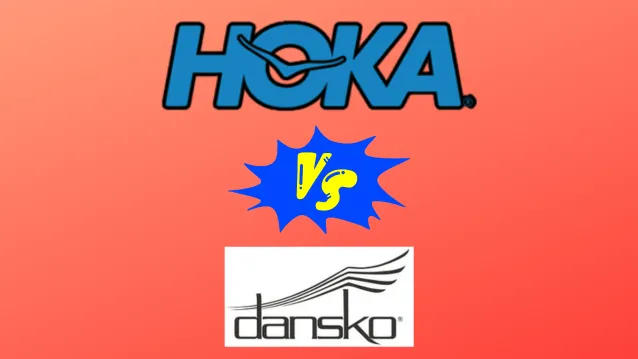When it comes to all-day comfort footwear, two brands stand apart from the competition – Dansko and Hoka.
But with different backgrounds, styles, and target users, how do these comfortable shoe giants compare? This in-depth post puts Dansko and Hoka head-to-head across key categories to help you decide which is best for your needs.
Comparison Table Between Dansko And Hoka:
| Features | Dansko | Hoka |
|---|---|---|
| Founded | 1990 in Denmark | 2009 in France |
| Comfort | Structured arch and heel support | Plush, pillow-like cushioning |
| Color Options | Neutral tones with some pops of color | Bold, vibrant color options |
| Durability | Very durable, shoes last years | Average 1-2 years per pair |
| Performance | Provides stability for long hours on feet | Lightweight, shock-absorbing for runners |
| Style | Clogs and casual shoes | Chunky athletic shoes |
| Popularity | Nurses, chefs, servers, tradespeople | Popular among trail runners |
| Bestseller | Professional clog | Bondi 8 |
Dansko Overview:
Dansko was founded in 1990 by husband and wife duo Peter Kjellerup and Mandy Cabot.

Based in Pennsylvania, Dansko first gained popularity for its signature clogs featuring excellent arch support, heel cups, and rocker bottoms designed to propel the foot forward.
By optimizing stability and comfort, Dansko shoes became a foot-saving staple for nurses, chefs, servers and others on their feet all day.
Beyond its iconic clogs, Dansko‘s lineup includes sandals, boots, sneakers and other comfort-focused footwear. Dansko collaborates with top footwear researchers to study gait efficiency and incorporate those learnings into its shoe designs.
It also partners with groups like the American Podiatric Medical Association to further foot health education and research.
Dansko shoes provide structured arch and heel support aimed at minimizing fatigue. Its clogs include molded heel cups to stabilize and support the foot, while the stiff midsole and rocker bottom provide shock absorption.
With natural materials and sturdy construction focused on stability, Dansko shoes are built to last through years of regular wear.
Hoka Overview:
Founded in 2009 by Nicolas Mermoud and Jean-Luc Diard, Hoka One One burst onto the scene with their super thick midsoles, aiming to provide maximum cushioning for runners.

Initially, their oversized design was polarizing. But as more runners experienced the plush ride, Hoka gained a cult following among ultramarathoners and trail runners.
Hoka remains focused on cushioning and stability to create a smooth, comfortable run. Signature technologies like the Meta-Rocker outsole encourage a natural gait cycle and transition. The roomy toe box allows your feet to splay and relax over long miles.
For runners who struggle with joint pain and hard impact, Hoka’s pillow-like foam brings sweet relief. The soft landings and energetic rebound make each stride feel effortless. It’s easy to see why Hokas have a reputation for comfort.
Hokas aren’t the most flexible shoe due to the higher platform. And the bulky silhouette isn’t for everyone. But for runners craving a cushy feel, Hoka delivers plush shoes that can go the distance in blissful comfort.
Major Differences Between The Brands:
When comparing Dansko and Hoka, several key distinctions emerge that can influence your choice. From comfort and durability to design and price, these factors contribute to each brand’s unique appeal. Let’s explore these differences in detail:
1) Comfort and Fit
Dansko offers more structured arch and heel support while Hoka prioritizes plush, pillow-like cushioning throughout the shoe. Dansko shoes have wider toe boxes while Hoka shoes run narrower.
Also Check Out: Hoka VS Brooks: Which is Better?
2) Durability and Performance
Dansko shoes are built to last, with many users wearing them comfortably for over 5 years before needing replacement. Their stiff midsoles provide excellent stability for long hours spent on your feet.
Hokas typically last around 1-2 years before the cushioning compresses. Their soft, responsive midsoles excel at shock absorption for athletic endeavors.
Also Check Out: Saucony VS Hoka: Which Is Better?
3) Price
Hoka shoes sit at a higher price point, retailing between $130-$170 per pair on average.
Dansko clogs and shoes have a lower average price around $100 or less. Hokas cost more due to their proprietary cushioning technology.
Also Check Out: Hoka VS On Cloud: Which Is Better?
4) Design and Style
Dansko shoes feature simple, functional styles like clogs and casual shoes in muted, neutral colors.
Hoka has more boldly athletic styles with bright pops of color and chunky designs spotlighting the thick midsoles. Dansko has a utilitarian aesthetic while Hoka shoes look more sporty.
Also Check Out: Hoka VS Adidas: Which Is Better?
5) Popularity
Dansko has a devoted following among nurses, restaurant servers, chefs, teachers, commuters and others needing comfortable, supportive shoes for long hours on their feet.
On the other hand, Hoka is popular among runners, hikers, walkers, and athletes wanting enhanced cushioning for an easy, gentle feel with each step.
Also Check Out: Altra Vs Hoka: Which Is Better?
6) Target Markets
Dansko targets professionals like nurses and restaurant workers who log long hours standing and walking. Hoka designs its shoes for athletic activities, targeting runners, hikers, walkers, and fitness enthusiasts wanting joint relief.
Final Verdict:
While Dansko and Hoka take different approaches, they both deliver exceptional all-day comfort.
For professionals needing durable support for long shifts standing, Dansko is a clear choice. But Hoka’s unparalleled cushioning offers the gentle ride preferred by athletes and active folks wanting joint relief.
So whether you spend your days on your feet at work or pounding the pavement training, choosing between these comfort stars comes down to your personal needs and priorities. With an understanding of their specialized strengths, you can pick the pair that’s just right for your lifestyle.

